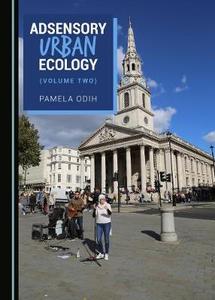Adsensory Urban Ecology (Volume Two)
Odih, Pamela. 2019. Adsensory Urban Ecology (Volume Two). Newcastle upon Tyne: Cambridge Scholars Publishing. ISBN 9781527524682 [Book]
![[img]](https://research.gold.ac.uk/26126/1.hassmallThumbnailVersion/9781527524682.jpg)
|
Image
9781527524682.jpg - Cover Image Download (24kB) | Preview |
Abstract or Description
Adsensory sign technology, which depicts the human body as both object and subject of inscriptive advertising technologies, is integral to a western capitalist insurantial financialisation of health and wellbeing. Developing further the theme of adsensory technologies of the sign, in conjunction with Daniel Bell’s theory of the codification of knowledge as an axial feature of the structuring of post-industrial society, this book explores gentrification in heterotopic post-industrial urban spaces. It brings together case studies from London’s Grenfell Tower, exploring perilous façadism refurbishment and London’s Garden Bridge project and speculative capital regeneration. These studies illustrate, empirically, the extent to which advertising adsensory technologies have become integral to the gentrification of post-industrial urban spaces. For instance, with respect to the London Brick Lane case study: Brick Lane street art is expressing 'authentic' local experience and intersections of race, class, gender. In its proximity (spatial, temporal, symbolic interactional contiguity), Fashion Street's artwork is also 'authentic', but its context is reconfiguring its cultural political function. Expressed briefly:
Odih, Pamela. 2019. #FassonStRedGoldBrickLane; Graffiti Ethno-map of Fashion Street’s Colonial History. Spitalfields Life: @thegentleauthor, London.
The photo-diary methodology utilised is empirically analytical rather than a photo-gallery exhibition; "the message necessitated the medium" (Odih 2013) and in its careful curation tries to allow the viewer to experience and decipher simulacra, and their disconnects, signifying the time-shifting and space-shifting of adsensory gentrification. Brick Lane case study empirical result is that the research on graffiti artists, reveals a consciousness and cultural political awareness, that insists Brick Lane and Fashion Street have a shared British colonial history of "red gold" expropriation from West Africa.
Several of the case studies engage critically with the empirical observation that, in the post-industrial urban ecology of inner-city regeneration, adsensory technologies extend avariciously into the infrastructure of neoliberal, managerialist gentrification. In addition, the book explores the forms of capital accumulation which are emerging from the integration of adsensory technology into the gentrification of post-industrial urban spaces, and examines a new form of capital accumulation in inner-city gentrification, predicated on the (de)generative integrity of adsensory financialisation.
Rigorous academic reviews include : Salleh, A., (2019); Accumulation in a Post-Industrial Ecology - Progress in Political Economy (PPE). Available at: https://www.ppesydney.net/accumulation-in-a-post-industrial-ecology/
Application and community engagement include: Bath Heritage Watchdog (2019); Bath Press News - Interest From A University, Bath Heritage Watchdog. Available at: http://www.bathheritagewatchdog.org/bpress.htm
Application and consultation engagement include: City of Westminster (2020); Busking Consultation; A New Policy for Street Performance in Westminster, Busking consultation | Westminster City Council. Available at: https://www.westminster.gov.uk/busking. With regards to the latter, the following was submitted to the Westminster City Council busking consultation public liability insurance proposals for buskers: Hitherto, the public liability of busking negligible; but now the risk ratio of £2million liability will either be a deterrent to busking or a multiplier of public liability insurance sales, as the industry attempts to socialise the risk probability of a claim, into the general population of public liability insurance. Individualising busking risk: #Unfare. Furthermore, contributing to the autumn 2020 online campaign https://savelondonbuskers.com the following series of social media posts authored by Dr. Pamela Odih, garnered thousands of impressions:
"@CityWestminster’s busking regulation: "You should hold public liability insurance of at least £2 million". Surely, in accord with "Law of Fixtures" (1876): “Quic quid plantatur solo, solo cedit”. Thus, city leaseholders have public liability to insure protection of the busker?".
For, it is my contention that the City Westminster busking regulations constitute a privatisation of public recreational space through an adsensory financialisation of public liability insurance; and an aesthetics of gentrification integral to adsensory urban ecology. Furthermore, my application of “Quic quid plantatur solo, solo cedit” to the plight of the City Westminster buskers, interpolates with the January 2021 announced Ministry of Housing, Communities and Local Government land regeneration policy entitled: "'Right to Regenerate' to turn derelict buildings into homes and community assets".
|
Item Type: |
Book |
| Keywords: |
Adsensory, gentrification, financialisation, Bath Press, Trafalgar Square busking community, Brick Lane street art |
| Departments, Centres and Research Units: |
|
| Date: |
14 March 2019 |
| Item ID: |
26126 |
| Date Deposited: |
03 Apr 2019 08:52 |
| Last Modified: |
16 Jan 2021 15:27 |
|
URI: |
View statistics for this item...
 |
Edit Record (login required) |

 Tools
Tools Tools
Tools
